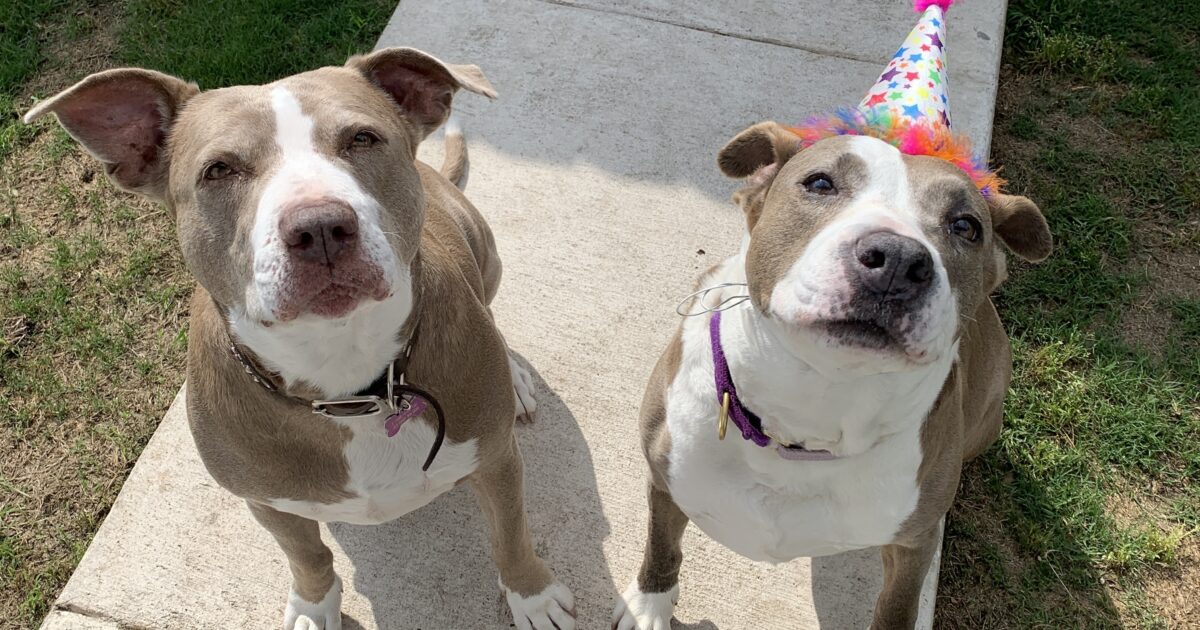
Jun 30, 2023
Austin Pets Alive! (APA!) fosters perform a vital role for all of the animals, but especially help improve the lives of dogs with behavioral challenges. During the dog’s time in a foster home, the foster can observe behavior, take notes and implement training and behavior modifications under the guidance of APA!’s Dog Behavior Program team to help these pets find adoptive homes.
Finding an adoptive home other than hers didn’t quite work out for APA! volunteer, turned foster, Alexandra Bobbitt, who experienced “failing in love.” Her foster, Girly, was already in her adoptive home the moment she stepped into Bobbitt’s world.
“I first met Girly at APA! when I brought my dog Bela, short for Beleza, to meet potential foster dogs. Several people mentioned Bela resembled Girly. Everyone talked about how lovable Girly was,” Bobbitt said.
She was intrigued immediately and visited Girly in the kennel. “As soon as I laid eyes on her sweet face, and saw how much she looked like Bela, I felt compelled to foster her!”
It soon became very apparent that the two pups created a loving duo that were stronger together than apart. “When you find a dog that fits with you, it’s difficult to let them go. Both Bela and Girly were like that. I couldn’t bear to part with (either of) them.”
The journey wasn’t easy for the three of them at first, but fortunately Bobbitt had the ongoing support of APA!’s Dog Behavior Team. Girly, for example, struggled with “stranger danger” and behavior issues while on the leash, which stems from her anxiety. If left unaddressed, the behavior could escalate to defensiveness.
“To address this, the APA! Dog Behavior Team introduced us to various training techniques and with the team’s continued support and supervision Girly has made significant progress,” she said.
One of those techniques is something called B.A.T., or Behavior Adjustment Training. This is often used by the APA! Behavior team as an alternative for the typical “leash reactivity training,” especially if the dog requires a greater threshold due to fear and anxiety.
“Now, friends can come over and within seconds she becomes their best friend,” Bobbitt said. “She has also become calmer on the leash.”
Since adding Girly to her home with Bela, Bobbitt continues fostering other pups to help them find their adoptive homes. There’s been Georgie, Chilli, Cruzito and most recently Cash who is currently still in APA!’s care. “Seeing the overwhelming number of overcrowded shelters across the country broke my heart, and I wanted to help in some way, so I decided to make a difference by fostering another pup and giving another deserving dog a chance.”
While Cash was in Bobbitt’s home as a temporary foster, the detailed observations she took while fostering him helps APA!’s Dog Behavior Program appropriately adjust his customized training program that focuses on offering him and his future person tools to lessen, adjust or all together remove any undesirable behaviors. Giving Cash this guidance helps make him that much more noticeable to potential adopters and will support his success in a future foster or adoptive home.
In the shelter, Cash has displayed a bit of separation or storm anxiety, but given space and decompression in her home, Bobbitt noticed that he no longer exhibited those anxieties! The behavior team can use those observations to help Cash’s future adoptive or foster home recreate that same relaxed behavior. He also has some trouble with his leash skills and in particular, becoming a bit reactive when on leash. With the behavior team’s guidance, patience and trial and error, Bobbitt and Cash found a method that works for Cash — always having a trusty toy handy (or in Cash’s mouth!) when on walks.
“Cash just wants to be a person’s best friend. He may be a bit hesitant on walks, but with consistency, I can tell he will gain confidence and become more comfortable, “she said. “Within just two weeks, he showed noticeable improvement.”
The APA! Dog Behavior team works closely with adopters and fosters alike to ensure that both people and pets are able to communicate, working together to find solutions. APA! intakes the animals that are at risk of euthanasia; when a dog becomes at risk at another shelter due to behavioral struggles, our team steps in. By taking some time to understand a dog’s behaviors, we can introduce tools and techniques that offer a harmonious life to both the dog and his or her future loving home.
Source: Austin Pets Alive












